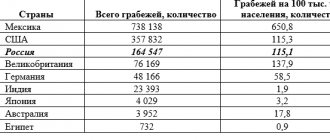Hooliganism and vandalism
Many people consider these terms to be synonymous.
Meanwhile, each of them characterizes a certain behavior that has its own specific features. Vandals do not always act with the intention of insulting someone or expressing protest to society. The bully’s motives, in turn, are exactly that. He commits his actions out of a desire to go against society. He violates generally accepted norms, law and order, demonstratively insults or expresses his disdain for the foundations. The most striking example is the fans. They attack people, destroy, damage or destroy public or private property.
Hooliganism and vandalism are united by the fact that both disrupt order. In the first case, illegal actions are directed primarily at other people. Vandalism mainly concerns property.
One of the striking differences between these acts is the form of their commission. Vandals, as a rule, act hidden. Hooligan actions, in turn, are committed openly - a person demonstratively shows disdain for other people or rules of conduct.
Desecration of buildings
Often there are reports and diplomas that are written on the topic under consideration. In this case, the authors must carefully study the topic and fully understand it. In particular, it should be understood what the legislator means by desecration of buildings. Changes in legislation do not affect this feature.
The concept under consideration involves the commission of actions, the result of which is giving a disfigured appearance to various real estate objects. It is worth noting that the entire building or part of it can be disfigured.
Such actions offend the morality existing in society. The Code of Administrative Offenses does not provide for similar provisions.
Vandalism will consist of the following actions:
- Making drawings of obscene meaning. In particular, these are various graffiti and inscriptions that contain obscene expressions that are cynical towards the public.
- The perpetrators put up posters containing immoral traits.
- Buildings and other structures are polluted through the use of dyes.
- Damage is caused to monuments of historical and cultural significance.
- A mockery of the values of history and spirituality.
The composition is not formed if the person did not pursue the goal of offending the morality of society or causing a public reaction. An example is the application of inscriptions on abandoned buildings.
Motivation
Each person, performing this or that action, is guided by something. If we talk about vandalism, it is quite difficult to clearly determine the motives of the criminals. Each guilty person is guided by his own needs and requirements. Meanwhile, it is believed that acts of vandalism are committed when an individual seeks to gain or regain control over people or a situation.
Different scientists carry out different classifications of motives for vandalism. For example, S. Cohen identifies the following types of vandalism:
- Acquisition. In this case, a person destroys one property in order to take possession of another.
- Tactics. In such a situation, an individual commits acts of vandalism to achieve a specific goal.
- Ideology. In this case, the vandal is pursuing a political or social goal.
- Revenge. Acts of vandalism are aimed at causing harm to the subject who insulted or offended the perpetrator.
- A game. Teenagers often commit rash actions, considering them a game.
- Anger. Vandalism, as mentioned above, can be based on personal hostility towards a specific person, envy, hostility.
Often, illegal actions are committed by people under the influence of ideological or other propaganda. As a rule, this situation occurs in groups of young people who form their own system of rules and stereotypes. There is a widespread belief in society that teenage vandalism is a normal phenomenon. In many ways, this conclusion was formed under the influence of the media. In addition, there is a minimum age limit for liability for vandalism under the Criminal Code. Art. 214 of the Code, like other criminal offenses, does not apply to persons who have not achieved it.
According to D. Kanter, the motives for vandalism are:
- Anger.
- Aesthetic experience.
- Existential research.
- Boredom.
Facts of vandalism indicate the imperfection of social structures responsible for raising the new generation. Mental stress, problems, lack of timely support are prerequisites for the development of internal aggression. A person can direct it both to another individual and to his property.
Difference from other crimes
The composition of the acts under consideration differs from other attacks. They are worth considering in more detail.
Difference from hooliganism
Hooliganism is understood as a violation of the order established in society. This manifests itself in a rude form, demonstratively. If we talk about vandals, they often act at night so that the encroachment is secret. Both compositions imply that the perpetrators pit themselves against the public. This can be expressed in a challenge to traditions, way of life and society as a whole.
The differences are that:
- Article 213 of the Criminal Code is open in nature;
- vandalism – does not attract public attention, but damage to property is necessarily caused.
It is worth paying attention to the fact that the severity of the harm caused does not affect qualifications. . Difference from property damage
Difference from property damage
Criminal law provides for penalties in situations where a person damages property. A person performs the action in question in relation to certain property belonging to a particular person. The item is personal property. When compared with Article 214 of the Criminal Code, the main difference is that the perpetrators in this case damage things located in places of public importance.
Also different are:
- The legislator, in relation to Article 167 of the Criminal Code, establishes the minimum amount that the damage should be equal to. In this case, it exceeds 5 thousand rubles.
- If we talk about vandalism, then such requirements are not fixed. This suggests that the harm caused may be minimal.
It is worth paying attention to the fact that a person can damage property due to hooligan motives. In this case, it is quite difficult to distinguish the composition from that provided for in Article 214 of the Criminal Code.
As an example from practice in this case, we can cite a situation where citizen V., who had quarreled with a person living next door, decided to kick the latter’s car. As a result of the committed action, the car caused damage in the amount of 8 thousand rubles. A squad of police was called to the scene and recorded the incident. Based on the results of consideration of the case materials in court, the competent person came to the conclusion that V. committed an act that falls under Part 2 of Article 167 of the Criminal Code. The culprit was sentenced to a fine.
Other differences
Rendering vehicles unusable is a separate element of illegal actions; this also includes means of communication. This is provided for in Article 267 of the Criminal Code. In practice, this act is rare. This composition differs from vandalism in that the perpetrator does not pursue the goal represented by a violation of the order established in society. The criminal only wants to render the transport unusable. The resulting consequences are more serious, since the result can be a disaster.
Vandalism should also be distinguished from the offense provided for in Article 243 of the Criminal Code. In this case, damage is caused to cultural monuments.
The differences are that:
- various real estate objects act as targets for vandals;
- according to the composition of Art. 243 of the Criminal Code damage is caused to works of art, sculptures and other objects.
Such objects are listed in the act “On Objects of Cultural Heritage” adopted at the federal level. What matters is what point of view the experts express on the issue. If they declare that the object is a monument of cultural significance, the assessment of the deed will be under Art. 243 CC.
Another element is committing desecration of the bodies of those who have died. In this situation, the actions of the perpetrator are aimed at violating moral principles, traditions and customs, but public order will not suffer. The legislation gives a separate assessment to actions aimed at desecrating objects located in burial places. An encroachment will not be considered vandalism if a person commits desecrating actions regarding the places where his loved ones are buried or other objects located in the cemetery.
Composition of the crime and criminal legal characteristics
- The direct object of the crime , that is, those social relations that the criminal encroaches on, are moral principles and customs for burying the bodies of the deceased. The criminal encroaches on national traditions in the field of burial, on the blessed memory and honor of people resting in burial places.
- The optional object , that is, what the criminal attempts indirectly, during the commission of the act, is the property of the relatives of the deceased, their intangible benefits.
The objective side consists of a number of actions. These include:
- Abuse of the remains of the deceased, which can be expressed in removal from the grave, dismemberment and other damage to the corpse, removal and theft of clothing and valuables, illegal burial in another place, and other cynical actions.
- Destruction of burial sites, structures and buildings on the territory of the cemetery in which memorial ceremonies are held. Actions that led to the destruction of the specified places or to their significant damage, in which their intended use becomes impossible.
- Damage to the specified objects, causing such damage as a result of which restoration and restoration are required.
- Desecration of objects by applying immoral inscriptions, images on them, leaving garbage and sewage in the indicated places with the aim of desecrating the burial site.
This crime has a material and formal composition. It is considered completed from the moment the consequences occur in the event of destruction or damage to the burial site.
In the case of committing actions to desecrate a burial place and desecrate the body of the deceased, the onset of socially dangerous consequences is not required, the crime is considered completed at the moment of commission of these actions.
The subject is a sane person who has reached the age of 16 . The legislator considered that full awareness of the illegality of one’s actions, their immorality and cynicism occurs by the specified age.
Younger adolescents may be driven by a desire for self-affirmation, imitation of elders, and other motives that are not directly related to the desire to damage morality and public interests.
The subjective side is characterized by direct intent . The criminal is aware of the social danger of his actions and desires the consequences.
If the harm was caused as a result of careless actions, there will be no crime. For example, if a driver, turning the car around near a burial site, inadvertently damages a tombstone, his actions will not be qualified under Article 244 of the Criminal Code of the Russian Federation due to the lack of direct intent.
What does judicial practice show under this article?
More often, guilty decisions are made under this article, since the crime poses a public danger and is expressed in insulting the morals and feelings of citizens.
Case studies:
- Citizen G. and his friends M. and P. were convicted of desecrating monuments in a cemetery. The investigation found that the citizens were intoxicated, destroyed 4 fences and painted obscene language on 5 monuments. The court sentenced everyone to arrest for 2 years and forced them to pay moral and material damages to the relatives of the deceased.
- Citizen P. was convicted of pouring paint on it and shouting an impartial slogan during the unveiling of a memorial plaque to a poet native of her city. The offender was immediately arrested and investigated. At the trial, she repented of what she had done, so she got off with a fine of 30 thousand rubles and compulsory labor for 120 hours.
- Citizen E. had previously been convicted of vandalism, the last time he and his friends depicted fascist symbols on the monument to the fighters for victory. Following the photographs that he posted on the Internet, the police arrested E. He confessed to what he had done, spoke about his accomplices, and they were also detained. E., as the perpetrator and organizer of the crime, was given 3 years of arrest and correctional labor. His accomplices got off with a fine.
What decisions are most often made under Article 214?
Under the article on vandalism, minors are judged according to the degree of their participation. If they are under 14 years of age, the parents bear the punishment, and the offenders themselves receive a warning or strict supervision. If a person is over 14 years old, he bears full responsibility. More often, guilty decisions are made under the article, the perpetrators are forced to pay fines and compensate for material or moral damage. When a group of people commits a crime, imprisonment is inevitable.
What are most often aggravating and mitigating circumstances?
A mitigating circumstance is that the offender is under 14 years of age. Public repentance and cooperation with the investigation can also reduce the sentence. The commission of a crime repeatedly by a group of persons with motives under Article 282 can aggravate the case and increase the sentence.
Punishment
Responsibility for this crime can begin as early as 14 years of age. The punishment for vandalism can be as follows:
- fine up to 40,000 rubles;
- compulsory work up to 360 hours;
- correctional labor for up to 1 year;
- restriction or imprisonment for up to 3 years (if the crime was committed by a group of persons or for national reasons).
Most often, vandals who break the law for the first time can get off with a suspended sentence or community service. Those who constantly commit such crimes may lose their freedom and be sent to a penal colony.
Damage to property in a public place
The length of punishment depends entirely on the circumstances of the act committed. This suggests that it is prescribed in each case individually. Everyone can justify themselves in any way.
When it comes to damage to property, the legislator means the complete destruction, destruction or damage of various things.
The property in question will be located:
- in places of public importance;
- on transport.
The indicated territories are considered unsuitable for use by those responsible. This happens in full or in part. The court evaluates an act committed on a large scale, or when significant damage is caused, in conjunction with the elements provided for in Article 167 of the Criminal Code.
Desecration
In judicial practice, under Article 214 of the Criminal Code of the Russian Federation, desecration is understood as various actions. In general, they are aimed at giving public structures/buildings, as well as their parts, an ugly appearance that violates
This may be expressed in:
- writing obscene poems, inscriptions, words, drawings of cynical content or obscene language;
- contamination of structures with sewage, coloring liquids and substances, damage to cultural and historical monuments or their individual elements, signs, doors, bas-reliefs;
- mockery of historical, spiritual, human values (for example, placing Nazi symbols on obelisks and monuments to fighters against fascism, writing inscriptions that offend the religious feelings of citizens).
Distinction between related offenses
To correctly qualify unlawful acts, it is necessary to distinguish between related crimes.
Vandalism - Article 214 of the Criminal Code of the Russian Federation
The crime provided for in Article 244 of the Criminal Code of the Russian Federation differs from the crime provided for in Article 214 of the Criminal Code of the Russian Federation for the object of the criminal attack.
- The object of vandalism is public safety and the normal functioning of society. A criminal, by committing acts of damage to property, infringes on the interests of people using this property. The subject of encroachments are structures, buildings, structures, transport facilities intended for public use.
- The object of desecration of bodies and desecration of graves is public morality, the memory of the deceased, their good name, and burial traditions. The objects of criminal assault in this case are the bodies of the deceased, tombstones and monuments, objects used to commemorate the dead.
Hooliganism - Article 213 of the Criminal Code of the Russian Federation
The object of hooliganism under Article 213 of the Criminal Code of the Russian Federation is public order. A hooligan disturbs the peace of citizens, wants to disturb the peace of citizens, and causes outrage with his actions.
Actions under Article 244 of the Criminal Code of the Russian Federation are directed against public morality and morality, affecting the following issues:
- burials of the deceased;
- preserving the memory of them;
- keeping the remains intact.
Commentary on Article 214 of the Criminal Code of the Russian Federation
Commentary edited by A.V. Brilliantova
The main object of vandalism is relations to protect public order.
An additional object is relations for the protection of public morality and property.
Subjects of the crime:
1) buildings and structures. Buildings - residential buildings, buildings of enterprises and institutions, churches, shops, libraries, clinics, etc. Structures – public transport stops, sculptural compositions, payphones, advertising stands, etc.;
2) property on public transport, in other public places (subway cars, seats, handrails of public transport, benches in parks, squares, in local areas, advertising banners, property of cinemas, clubs, museums, etc.).
Monuments of history and culture (Article 243 of the Criminal Code of the Russian Federation), gravestones, cemetery buildings, burial places of the dead (Article 244 of the Criminal Code of the Russian Federation), personal vehicles (Article 167 of the Criminal Code of the Russian Federation) are not subject to vandalism.
The Russian language dictionary defines vandalism as the senselessly cruel destruction of historical monuments and cultural values, barbarism. This crime was structurally separated from hooliganism; before the adoption of the Criminal Code of the Russian Federation, such actions were qualified as criminal hooliganism.
The objective side of the crime consists of committing such actions as:
1) desecration of buildings or other structures;
2) damage to property on public transport or in other public places.
The term “defilement” means disgrace, subjected to reproach, humiliation. The actions of vandals consist of applying inscriptions, drawings of cynical, obscene images to buildings and structures, staining them with sewage, etc.
Damage means damage, rendering unusable property on public transport, in other public places (cut up seats, bent handrails, torn payphone tubes, burnt mailboxes, broken benches). Damage is also the application of inscriptions and drawings on buildings, fences, barriers in public places that do not offend public morals, for example graffiti, inscriptions of political or religious content. In Art. 214 of the Criminal Code of the Russian Federation does not indicate the amount of damage caused by the damage. From the standpoint of the theory of criminal law, this means that this circumstance does not affect qualifications. At the same time, if there are signs of a clearly minor act, as defined in Part 2 of Art. 14 of the Criminal Code of the Russian Federation, it is necessary to state the absence of this crime.
When committing such actions in places that are not public, for example, destroying the fence of a country house, drawing drawings on the veranda of a private cottage, the actions are qualified if there is evidence of significant damage under Art. 167 of the Criminal Code of the Russian Federation
The corpus delicti is formal. The act is completed from the moment the property is desecrated or damaged.
The subjective side of the crime is characterized by direct intent. The motive for the action is not specified in the disposition of the article, but it can only be hooliganism. In some cases, only a motive allows one to distinguish vandalism from crimes against property. For example, the culprit tore out a seat in a bus. With hooligan motives, actions form part of vandalism, with mercenary motives - theft of someone else's property.
The general subject of the crime is a sane person who has reached the age of 14 years.
Part 2 of Art. 214 of the Criminal Code of the Russian Federation establishes stricter criminal liability for vandalism committed by a group of persons (Part 1 of Article 35 of the Criminal Code of the Russian Federation - a group of persons without prior agreement), as well as for reasons of political, ideological, racial, national or religious hatred or enmity, or for reasons hatred or hostility towards any social group
It should be noted that vandalism committed with other forms of complicity should be qualified under Part 1 of Art.
214 of the Criminal Code of the Russian Federation, which, in our opinion, will not correspond to a fair solution to the issue of criminal liability.
Vandalism committed for reasons of political, ideological, racial, national or religious hatred or enmity, or for reasons of hatred or enmity against any social group, should be distinguished from hooliganism committed for the same reasons. Vandalism not only disrupts public order, but also causes damage to property through desecration of buildings and other structures, damage to property in transport or other public places. In cases where, along with vandalism (Article 214 of the Criminal Code of the Russian Federation), a person commits hooliganism, liability for which is provided for in Art. 213 of the Criminal Code of the Russian Federation, the act should be qualified according to the totality of the named articles of the Criminal Code of the Russian Federation
Characteristics of the crime
The severity of this criminal act varies from small to medium (Article 15 of the Criminal Code of the Russian Federation), therefore, criminal liability is imposed for desecration of graves in accordance with Art. 244 of the Criminal Code of the Russian Federation.
The Criminal Code of the Russian Federation classifies the desecration of graves as crimes against morality. It includes humiliation of the feelings of people close to the deceased and disrespect for memory. The act is also associated with property damage in the form of destroyed tombstones and monuments, as well as places where posthumous ceremonies were held. Thus, close relatives suffer not only moral suffering, but also material damage.
Crimes of desecration of graves are characterized by particular cynicism and low morality of the offender. A typical psychological portrait of a cemetery vandal is characterized by nervous and mental disorders, a feeling of dissatisfaction and a tendency to a perverted perception of reality. In most cases, the criminal does not derive material benefit from his actions, is content with the process of abuse itself, and most often commits a crime spontaneously.
You are advised by the best qualified lawyers
Free: Our lawyers provide free initial consultation on any legal issues. 90% of cases are resolved with one free consultation.
24/7: real estate via online chat, or call the hotline 24 hours a day, 7 days a week
Vandalism at the cemetery
This is a special category of crimes that requires close attention from law enforcement agencies. It should be said that criminal law shares responsibility for acts of vandalism and desecration of burial sites.
Relatives of the deceased come to the graves to honor their memory. They take care of the burial site, arrange flowers, remove weeds and debris. The actions of vandals who destroy graves, dig up bodies, and write inscriptions insulting both the deceased and their loved ones have an extremely negative impact on relatives.
There are individuals who use cemeteries as places for rituals and even sacrifices. Relatively recently, the actions of one girl who killed animals on graves caused a great stir.
Often, acts of vandalism in the cemetery are committed by teenagers in a state of intoxication. The motive may be the desire to assert oneself among peers, to arouse affection from adults, etc. Actions associated with:
- Violation of the integrity of graves. We are talking about damage to tombstones, digging up a burial site, destruction of a coffin, etc.
- Desecration of the body of the deceased. There is such a thing as necrophilia. It involves committing violent acts with a corpse.
- Applying obscene inscriptions and drawings on monuments and tombstones.
Responsibility for desecration of graves
A conviction for such a crime can carry a penalty ranging from a fine to 5 years in prison. When making a decision, the court will proceed from the totality of the circumstances of the case, as well as assess the personality of the criminal and his attitude to the crime. As already noted, a number of aggravating features are already contained in Part 2 of Art. 244 of the Criminal Code of the Russian Federation, the court has no right to take them into account again.
Special attention should be paid to the issue of the use of violence or its threat during vandalism. This rule includes in the crime the possibility of inflicting only beatings or causing minor harm to the health of the victim. If moderate or severe harm was caused during the desecration of graves, sanctions will be calculated based on the totality of Articles 244, 111 or 112 of the Criminal Code of the Russian Federation.
Inscriptions, symbols and drawings in a cemetery are punishable by at least a fine of up to 40 thousand rubles. Other actions to violate the grave and the deceased will result in punishment in the form of forced labor and even arrest for up to 3 months.
The qualified elements of the crime include restriction of freedom, forced labor, arrest for up to 6 months or 5 years of imprisonment.
Grave desecration and cemetery vandalism constitute the lowest level of moral crimes. Contempt for traditions, rituals and ceremonies is expressed through damage to both property and the feelings of living citizens towards the deceased. Responsibility under Art. 244 of the Criminal Code of the Russian Federation provides for a wide range of punishments depending on the nature of the offender’s actions. If you have any questions on this topic, you can address them to our qualified lawyers. Help is available online and by phone numbers provided.
Vandalism as a social problem
It is no coincidence that the legislator distinguished vandalism from other illegal actions. The objective aspect of this crime is not only the violation of ethical and legislative norms, but also the infliction of significant material damage.
The urgency of the problem of vandalism has increased greatly in the last few years. This is due to the fact that some informal groups promote aggressive forms of protest. It is primarily young people who fall under this influence.
The reasons for the massive surge in illegal actions lie in insufficient prevention. Vandalism is a social problem that must be solved jointly with the state.
Most lawyers agree that the punishment provided for in Art. 214 of the Criminal Code of the Russian Federation, is not strict enough and does not correspond to either the nature of the crime or the severity of the consequences. Researchers believe that sanctions for vandalism need to be tightened. After all, such acts not only violate public order, but also often cause significant property damage. Large sums of money are needed to restore the appearance of buildings and structures, monuments, gardening equipment, property, and public vehicles. Experts believe that compensation for these costs should be borne by the convicted. The fine provided for in the Criminal Code for vandalism (about 40 thousand rubles) does not cover these expenses.
Lawyers propose changing the category of crime. Currently, vandalism is recognized as an act of minor or moderate gravity (depending on the presence of qualifying features). Lawyers believe that this categorization does not correspond to the degree of danger of the act.
Desecration of the bodies of the dead and their burial places
It is not necessary to completely destroy the object of desecration for the court to determine the presence of corpus delicti in the actions of the attacker. It is enough to damage it or apply inscriptions, symbols or other designs.
If we are talking about the body of the deceased, then any manipulations associated with its removal from the grave are considered illegal. Thus, as a result of the crime, both immovable objects and the deceased himself may suffer. When we talk about the fact of abuse, we consider actions that contradict religious and moral principles associated with funeral and memorial traditions.
The criminal, when committing acts of desecration of graves, acts deliberately and assumes the amount of the resulting damage. It is impossible to commit desecration through negligence.
Only persons over 16 years of age will be tried for this crime according to the general rule of Art. 20 of the Criminal Code of the Russian Federation. An exception will be made for insane and incompetent persons, as well as those lagging behind in mental development compared to their physical age.
Desecration of graves includes 2 types of crimes depending on the number of aggravating circumstances. An act committed as part of a group of people, motivated by hatred or with the use of force, intimidation, transfers it from a low degree of severity to a medium one, directly increasing the penalties.
General information
Many believe that vandalism is such actions that are aimed solely at desecrating cultural and historical structures. This is not entirely true.
This phenomenon can be viewed from different points of view. For example, what is vandalism in a psychological sense? It is understood as a state of a subject in which he wants to commit destructive actions, desecrate sculptures, monuments, and cause damage to public property. The opposite of it will be patriotism. It represents a state in which an individual is proud of the country and people and strives to preserve the cultural and historical heritage.
Some scientists believe that vandalism is a form in which the subject commits meaningless actions, thus trying to attract attention to himself. As a rule, destructive behavior is characteristic of dissatisfied people who have not achieved anything in life.







